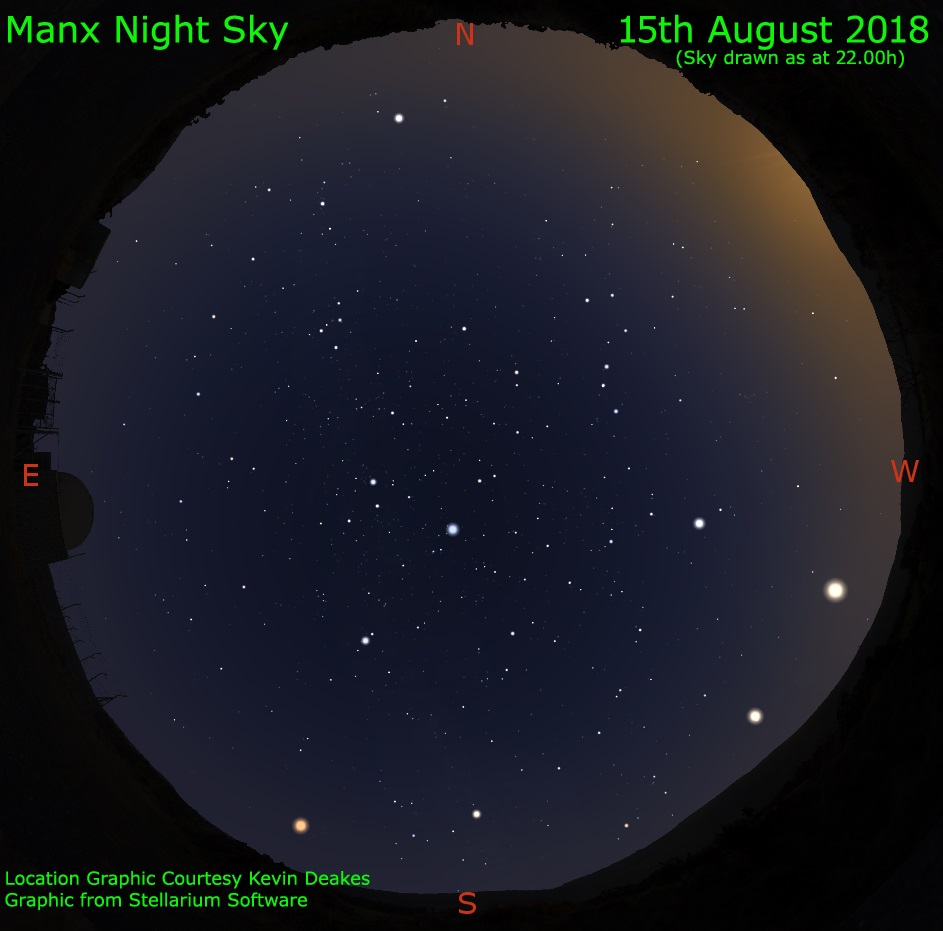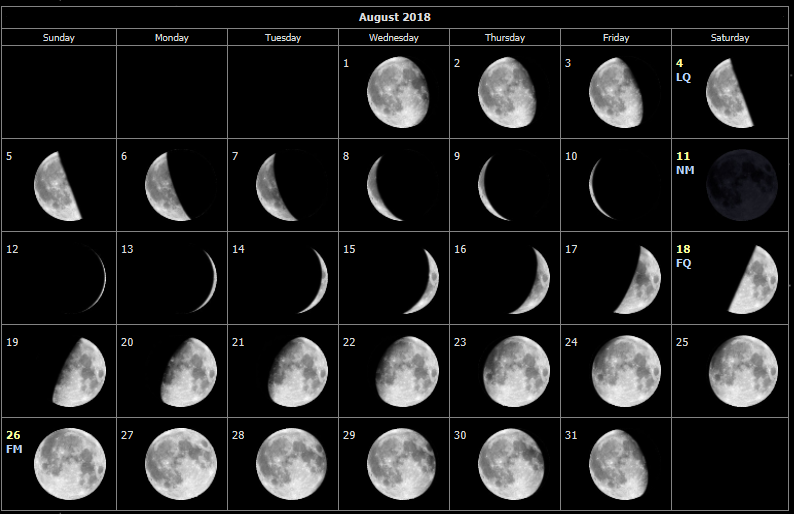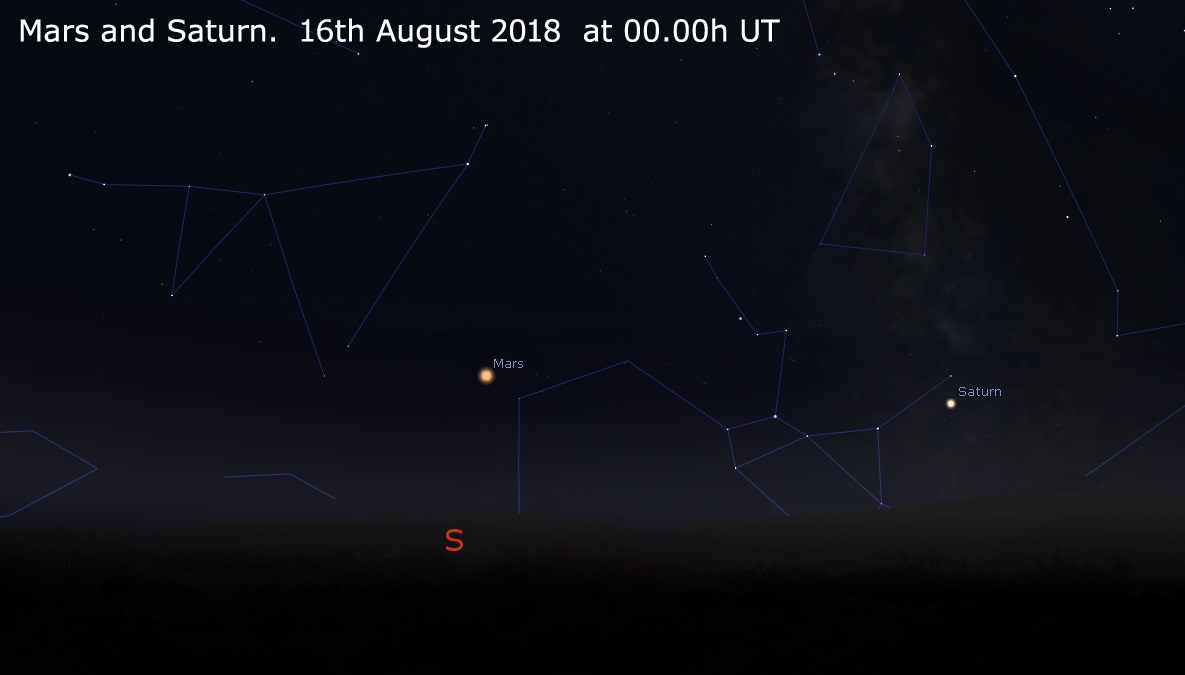In Manx skies... August 2018 ~ compiled by Dave Storey
New
11th
at
09.59h
First Quarter
18th
at
07.50h
Full
26th
at
11.57h
Last Quarter
4th
at
18.19h
Note: All
times are Universal Time (UT)
British
Summer Time is now in force. Remember to add 1 hour to any times
quoted here to get local IoM time.
There is a partial
solar eclipse on the 11th
.
Non of the eclipse will be seen from the Isle of Man. Click
here for details.
Solar activity is low with solar cycle 24 now in force.
WARNING: NEVER DIRECTLY OBSERVE THE SUN WITH YOUR NAKED EYES AND/OR OPTICAL INSTRUMENTATION: YOU WILL BE BLINDED!
Carrington's Solar Rotation number 2207 starts on the 6th at 01h43m45s.

Is
not visible during the first half of the month as it is too close
to the Sun. It goes through inferior
conjunction (between the Earth and Sun) on the 9th
when it passes 4.7° south of
the Sun. It moves into the dawn skies and will be visible during
the last two weeks of the month. It gets to greatest western
elongation on the 26th
when it will be 18° to the
right of the Sun.

Is
an evening object, very bright in the west after sunset. The
planet will shine at magnitude
-4.3 on the 1st,
setting at 21.35h. By the end of the month, it will have increased
to a very bright -4.6, setting at 20.02h. The line of the ecliptic
plane makes a shallow angle with the western horizon after sunset
and this will cause Venus to be low once the sky gets dark enough.
The planet reaches greatest
eastern elongation on the 17th
when it will be 46° to the
left of the Sun. On
the 15th
, Venus' phase is calculated to
be 50% illuminated ( known as dichotomy) but there is a phenomenon
know as the SchrÖter
Effect where the observed phase of Venus at 50% illuminated occurs
a few days earlier than prediction. See what date you see Venus at
50% phase. Of course, you'll need the use of a telescope to see
the phase.

Is
in Capricornus shining at magnitude
-2.8 and moving in a east to west (retrograde) direction. On the
24th,
it moves into the constellation Sagittarius and slows down to turn
direction on the 28th
when it starts moving west to
east in a direct motion. By the end of the month, the planet will
have faded to -2.1.
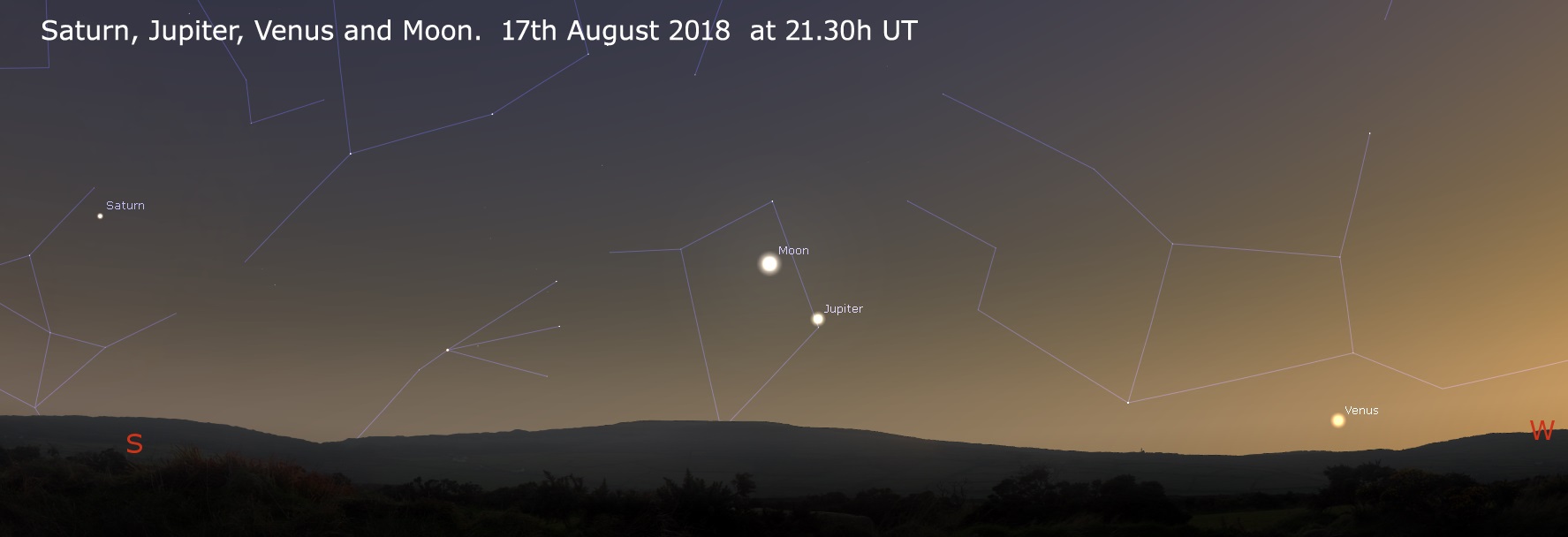
Will
be found low down in Libra soon after sunset in the south west. It
will fade in brightness from -2.1 to -1.9. The planet sets at
23.03h at the start of the month and by 21.11h at months end. Due
to the low altitude of the planet this month, the view as seen
through a telescope will be degraded.
As the moons orbit Jupiter, there are occasions when the shadow of the moons can be seen upon the surface of Jupiter and the moons can transit across Jupiter's disc. Also, the moons can be seen to be occulted or eclipsed by Jupiter. There are many events throughout the month. See periodicals such as the BAA Handbook, Astronomy Now and Sky at Night magazines for listings.
To help you identify the moons at any particular time, Sky and Telescope have a Java tool that will plot the moon positions. Click Here.
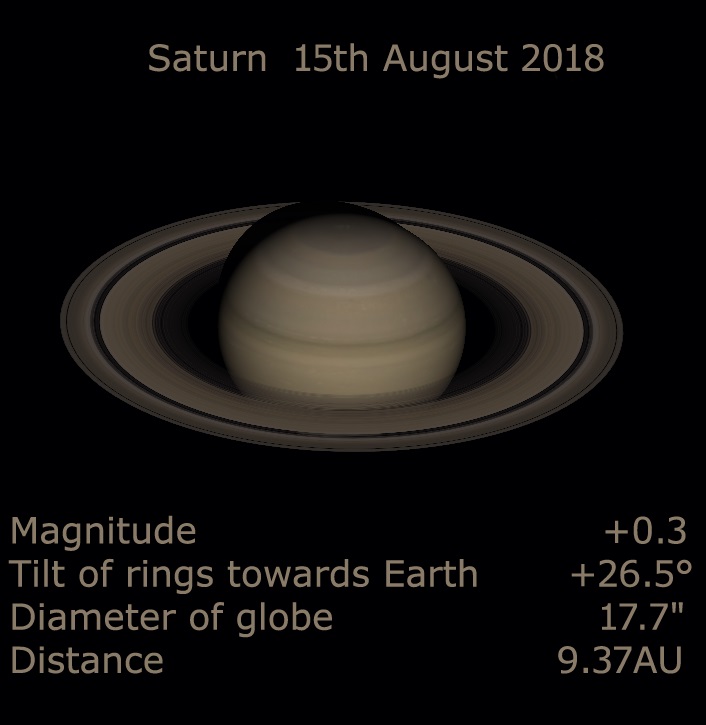 The
ringed planet will be found low in the south to south western
skies during the month in Sagittarius. It shines at magnitude
+0.2 to +0.4. The moon Titan (magnitude +8.6) will be found west
of the planet on 1st
,2nd
,3rd
,16th
, 17th
and 18th
. It will be east of the planet
8th ,9th
,10th
,11th
,24th
,25th
,26th
and 27th
.
The
ringed planet will be found low in the south to south western
skies during the month in Sagittarius. It shines at magnitude
+0.2 to +0.4. The moon Titan (magnitude +8.6) will be found west
of the planet on 1st
,2nd
,3rd
,16th
, 17th
and 18th
. It will be east of the planet
8th ,9th
,10th
,11th
,24th
,25th
,26th
and 27th
.
alpha-Cygnids became active during July and continue into August. There is the second peak of activity on the 21st when 5 meteors per hour (ZHR) will be seen. Radiant is at RA. 21.00h Dec. +48°
Capricornids were active during July and continue in August. There were three peaks of activity in July and August will consist of the tail end of this weak shower. These meteors can display yellow-blue colours. Radiant is at RA. 20.44h Dec. -15°
delta-Aquarids continue from July until 20th August. A second peak of activity occurs 6th August. The peak will be 10 meteors per hour (ZHR) and situated at radiant RA. 23.04h Dec. +02°. These meteors are usually faint.
Alpha-Capricornids were active from July and continue to 20th August. Peak activity is low, occurring on the nights 2nd - 3rd . With only 5 meteors per hour (ZHR), it is still worth a watch as this shower produces some long, slow moving fireballs. Radiant is at RA. 20.36h Dec. -10°
iota-Aquarids continue to be active from July and into August with a peak due 6th August. This is another weak shower with only 8 meteors per hour (ZHR) at peak. Radiant is at RA. 22.10h Dec. -15°
Perseids are active this month with a peak occurring on the 13th at 01.00h. Peak rate is 80+ meteors per hour (ZHR). The moon will be just past New Moon so the sky will be moonless for the shower this year, making observing very good. Radiant is at RA 03h13m Dec. +58°
Date Time ZC# SAO# Magnitude. P.A. Type of event. Notes
05 01.00:48 444 93232
5.9 279
RD D*
Moon Low
21 22.46:41 2704 187071
5.9 021
DD
Click
on date/time to display graphic of occultation event.
For
very detailed list of occultations visible this month, click
here. (Data from Occult Software)
Times
are UT as seen from IoMAS Observatory. Start to observe these
events about 20 minutes before the above times to allow for
differences in your latitude and longitude. This will give you
time to locate the star that is about to be occulted.
ZC
= Zodiacal Catalogue. Type of Event DD = disappearance at dark
limb, RD = Reappearance at dark limb. RB = Reappearance on bright
limb. PA = Position Angle around limb of the Moon, where 0 degrees
is north, 90 degrees is east, 180 degrees is south and 270 degrees
is west.
D* = Double Star M*=Multiple Star.
The above predictions were calculated from Occult software by David Herald. More information regarding this software may be found at the lunar-occultations.com web site.
This star drops from magnitude +2.1 to +3.4 in about 5 hours. Suitable events visible from the Isle of Man this month occur on 18th at 01.00h. Click here for a star chart for Algol.
Comets
(Brighter than +10)
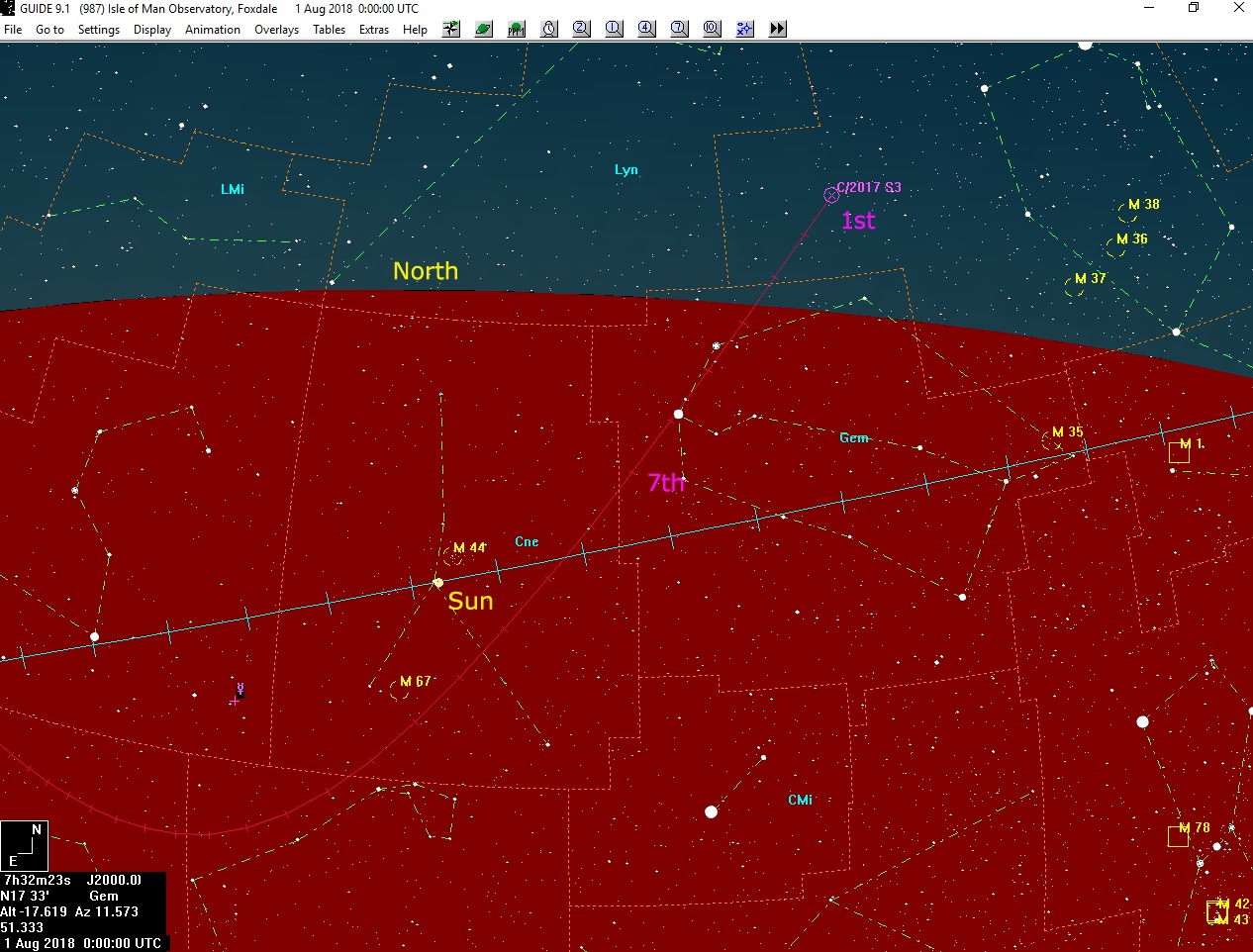
Comet
C2017 S3 Panstarrs is low in the north east in dawn skies during
first week of the month. It is predicted to be brighter than
magnitude
10 but at the time of writing these notes, indications are that
the comet has faded as it approaches the Sun with indications that
it is breaking up. It is not well place for viewing as it will be
low down and in a brightening dawn sky.
The international Space Station crosses the Manx skies on a regular basis. For the latest information on when the ISS is due to pass across the sky over the next ten days, visit the link below.
Bibliography for Manx Night Skies
The
Handbook of the British Astronomical Association 2018. BAA.
2017
2018 Stargazing. Heather Couper & Nigel Henbest.
Philip's 2017
2018 Guide to the Night Sky. Storm Dunlop &
Wil Tirion. Collins 2017
Yearbook of Astronomy 2018. Brian
Jones/Richard Pearson. Pen & Sword White Owl. 2017
Observer's
Handbook Meteors. Neil Bone. Philip's 1993
Atlas of the Night
Sky. Storm Dunlop. Collins. 2005
Constellations. Josef Klepešta
and Antonin Rükl. Hamlyn. 1979
Brilliant Stars. Patrick
Moore. The Book People Ltd. 1996
Complete Guide to Stargazing.
Robin Scagell. Phillip's. 2006
Turn Left at Orion. Guy
Consolmango and Dan M. Davis. Cambridge U.P. 2008
Norton's
2000.0 Edited Ian Ridpath. Longman Scientific & Technical.
1989
Planetary data derived from
Guide 9
Software.
Picture graphics derived from Stellarium
and Guide 9 Software.
